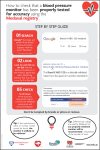How to check whether a blood pressure monitor has been properly validated for accuracy
- PMID: 33017506
- PMCID: PMC8030032
- DOI: 10.1111/jch.14065
How to check whether a blood pressure monitor has been properly validated for accuracy
Abstract
Hypertension guidelines recommend that blood pressure (BP) should be measured using a monitor that has passed validation testing for accuracy. BP monitors that have not undergone rigorous validation testing can still be cleared by regulatory authorities for marketing and sale. This is the situation for most BP monitors worldwide. Thus, consumers (patients, health professionals, procurement officers, and general public) may unwittingly purchase BP monitors that are non-validated and more likely to be inaccurate. Without prior knowledge of these issues, it is extremely difficult for consumers to distinguish validated from non-validated BP monitors. For the above reasons, the aim of this paper is to provide consumers guidance on how to check whether a BP monitor has been properly validated for accuracy. The process involves making an online search of listings of BP monitors that have been assessed for validation status. Only those monitors that have been properly validated are recommended for BP measurement. There are numerous different online listings of BP monitors, several are country-specific and two are general (international) listings. Because monitors can be marketed using alternative model names in different countries, if a monitor is not found on one listing, it may be worthwhile cross-checking with a different listing. This information is widely relevant to anyone seeking to purchase a home, clinic, or ambulatory BP monitor, including individual consumers for use personally or policy makers and those procuring monitors for use in healthcare systems, and retailers looking to stock only validated BP monitors.
Keywords: ambulatory blood pressure/home blood pressure monitor; blood pressure determination; device; validation.
© 2020 Wiley Periodicals LLC.
Conflict of interest statement
Aletta E Schutte: Her University has received equipment and funding from manufacturers of BP devices including IEM and Omron. Azra Mahmud has received equipment and research funding from manufacturers of BP devices including AtCor Medical and IEM but has no personal commercial interests in these or any other BP companies. Raj Padwal: Canadian representative to the ISO Sphygmomanometer committee and sits on the AAMI Sphygmomanometer committee. Co‐Founder and CEO of a digital health company (mmHg Inc), based at the University of Alberta. James E Sharman: His university has received equipment and research funding from manufacturers of BP devices including AtCor Medical, IEM and Pulsecor (Uscom). He has no personal commercial interests related to BP companies. Cintia Lombardi and Pedro Ordunez are staff members of the Pan American Health Organization. The authors alone are responsible for the views expressed in this publication, and they do not necessarily represent the decisions or policies of the Pan American Health Organization. Tammy Brady: is Co‐Chair of the Association for the Advancement of Medical Instrumentation (AAMI) Sphygmomanometer Committee and is a nominated expert on the IEC (International Electrotechnical Commission)/ISO (International Organization for Standardization) joint working group on non‐invasive blood pressure monitoring devices. The remaining authors have no disclosures.
Figures



References
-
- GBD Risk Factor Collaborators . Global, regional, and national comparative risk assessment of 84 behavioural, environmental and occupational, and metabolic risks or clusters of risks for 195 countries and territories, 1990–2017: a systematic analysis for the Global Burden of Disease Study 2017. Lancet. 2018;392(10159):1923‐1994. - PMC - PubMed
-
- Ettehad D, Emdin CA, Kiran A, et al. Blood pressure lowering for prevention of cardiovascular disease and death: a systematic review and meta‐analysis. Lancet. 2016;387(10022):957‐967. - PubMed
-
- Pickering TG, Hall JE, Appel LJ, et al. Recommendations for blood pressure measurement in humans and experimental animals: Part 1: blood pressure measurement in humans: a statement for professionals from the Subcommittee of Professional and Public Education of the American Heart Association Council on High Blood Pressure Research. Hypertension. 2005;45(1):142‐161. - PubMed
-
- Williams B, Mancia G, Spiering W, et al. 2018 ESC/ESH Guidelines for the management of arterial hypertension: The Task Force for the management of arterial hypertension of the European Society of Cardiology and the European Society of Hypertension: The Task Force for the management of arterial hypertension of the European Society of Cardiology and the European Society of Hypertension. J Hypertens. 2018;36(10):1953‐2041. - PubMed
-
- Whelton PK, Carey RM, Aronow WS, et al. 2017 ACC/AHA/AAPA/ABC/ACPM/AGS/APhA/ASH/ASPC/NMA/PCNA Guideline for the Prevention, Detection, Evaluation, and Management of High Blood Pressure in Adults: A Report of the American College of Cardiology/American Heart Association Task Force on Clinical Practice Guidelines. J Am Coll Cardiol. 2018;71(19):e127‐e248. - PubMed
Publication types
MeSH terms
Grants and funding
LinkOut - more resources
Full Text Sources
Medical

